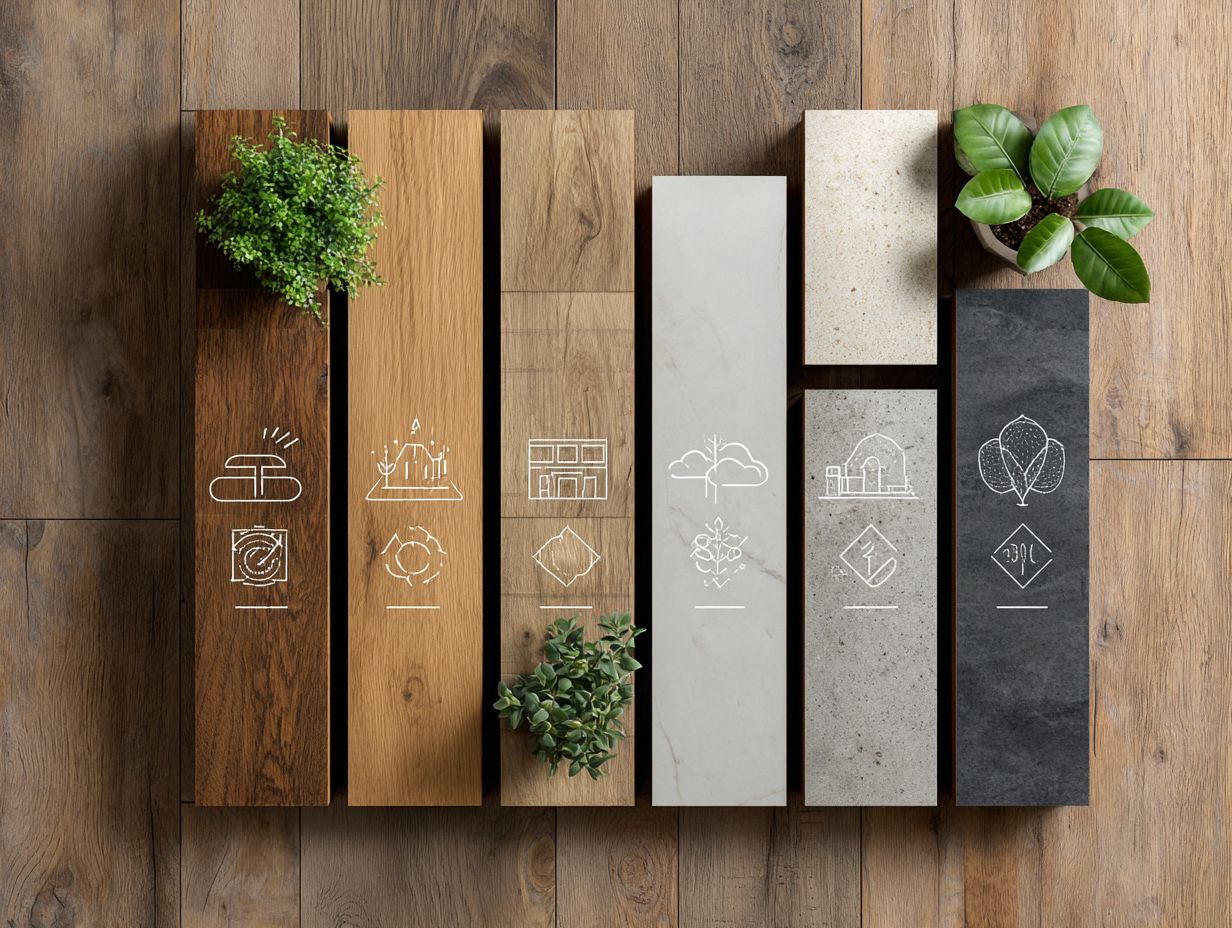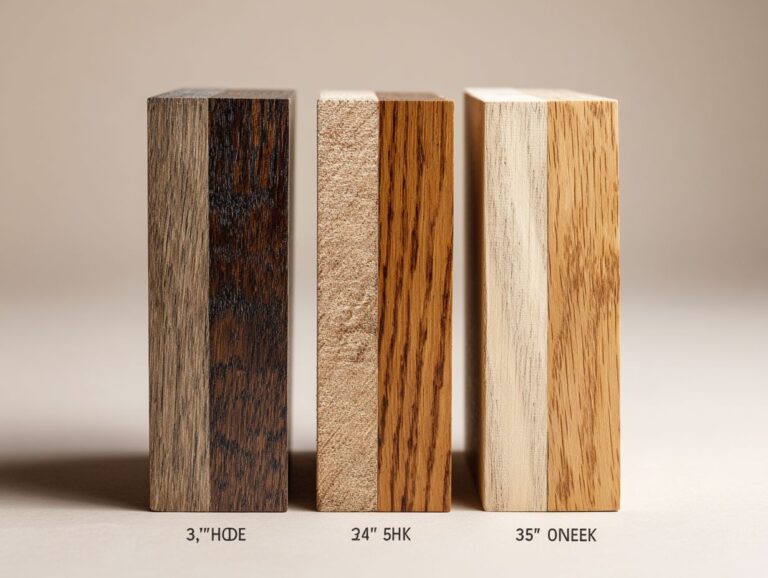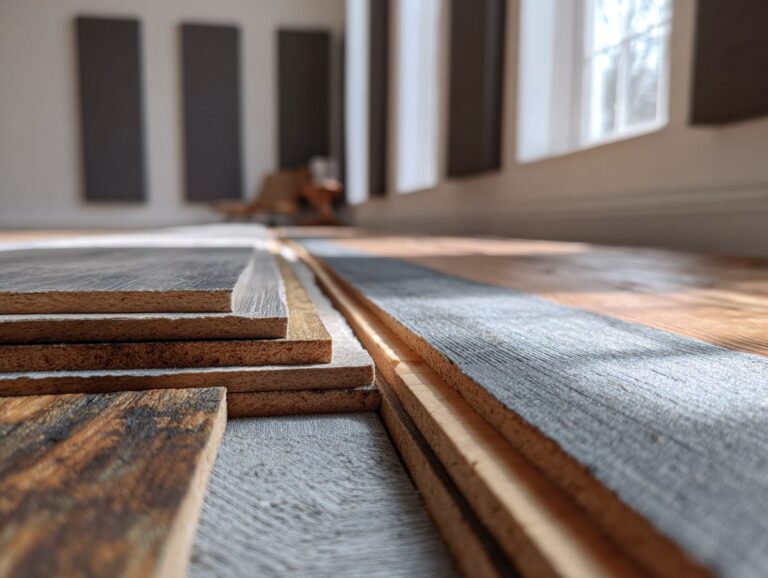Carbon Footprint of Flooring Materials – Eco Analysis
Choosing the right flooring is more than an aesthetic decision; it significantly impacts our planet’s health. This article looks at the carbon emissions linked to different types of flooring, focusing on environmentally friendly building practices. It uses Environmental Product Declarations according to ISO 14025 and EN 15804 standards. Get reliable information on how various materials compare, helping you choose options that are environmentally friendly. Let’s dive into the environmental impact of your flooring options.
Key Takeaways:
Contents
- Types of Flooring Materials
- Life Cycle Assessment (LCA) Methodology
- Carbon Footprint of Natural Flooring Materials
- Carbon Footprint of Synthetic Flooring Materials
- Carbon Footprint of Recycled Flooring Materials
- Comparative Analysis of Flooring Materials
- Flooring Materials Carbon Footprint Data
- Frequently Asked Questions
- What is the carbon footprint of flooring materials?
- Why is it important to consider the carbon footprint of flooring materials?
- How is the carbon footprint of flooring materials calculated?
- Which flooring materials have the lowest carbon footprint?
- What are some ways to reduce the carbon footprint of flooring materials?
- How can I find out the carbon footprint of a specific flooring material?
Definition of Carbon Footprint

The carbon footprint is the total amount of greenhouse gases produced by a person, group, event, or product, expressed in terms of CO2.
On average, each household generates approximately 48 tons of CO2 emissions annually. When selecting flooring materials, this impact is tangible.
For instance, choosing bamboo floors can reduce your carbon footprint by utilizing a fast-growing resource that sequesters carbon. In contrast, traditional hardwood floors, sourced from old-growth forests, may increase emissions due to deforestation.
Using recycled materials or low-VOC products reduces greenhouse gas emissions, so choosing wisely during construction is important for sustainability.
Importance of Assessing Carbon Footprint
Evaluating carbon emissions is important for designers and sustainability managers to reduce harm to the environment and make better choices about the energy use of construction materials.
Using tools like the Carbon Trust’s Footprint Calculator can provide information on emissions related to various materials.
For example, one case study involving a green building project revealed that switching from traditional concrete to recycled aggregate reduced overall carbon emissions by 30%.
Meeting standards like BREEAM and LEED improves a project’s reputation for being eco-friendly and can also lead to financial benefits.
Looking at these factors early can lead to design changes that improve how materials are used and greatly cut emissions over the building’s life.
Types of Flooring Materials
The type of flooring used in a building plays a big role in its environmental impact, with choices differing greatly in terms of sustainability, price, and environmental effects.
Natural Flooring Materials
Natural flooring materials, including hardwood and bamboo, are often favored for their renewable resources and lower life cycle impacts.
Among these options, Marmoleum is notable, made from natural linseed oil, wood flour, and jute, which makes it biodegradable and able to absorb CO2 during its production.
Junckers offers eco-friendly hardwood flooring sourced from sustainably managed forests. Both brands emphasize transparency in their sourcing processes, with certifications like FSC (Forest Stewardship Council) ensuring responsible logging practices.
Selecting these materials improves the look of indoor spaces and helps lower carbon emissions, showing that style and being eco-friendly can go together.
Synthetic Flooring Materials
Synthetic flooring materials, such as luxury vinyl tile and carpet tiles, while practical, often have higher carbon emissions due to fossil fuel-based production.
To mitigate these impacts, look for flooring solutions certified with eco-labels like ISO 14025, which indicates a commitment to sustainability.
Brands like Interface and Mohawk sell products made from recycled materials and use methods that lower carbon emissions.
Consider options like cork or bamboo flooring, which have lower emissions during manufacturing. Opting for locally sourced materials can also minimize transportation emissions, further enhancing your project’s sustainability profile. Related callout: explore our comparison of water-based vs oil-based polyurethane finishes for further insights into sustainable flooring choices.
Recycled Flooring Materials
Recycled flooring materials use waste products from consumers, greatly reducing their environmental effects and attracting environmentally aware buyers.
For instance, recycled rubber flooring repurposes tire waste, creating durable surfaces for gyms and playgrounds, while maintaining elasticity and shock absorption.
Cork flooring, derived from the bark of cork oak trees, provides a sustainable option by enabling trees to regenerate, thus promoting biodiversity.
According to industry statistics, the use of recycled materials in flooring has reached 20%, up from just 10% a decade ago, showing clear growth.
Buying these materials cuts down on waste in landfills and supports recycling efforts, drawing in eco-friendly shoppers.
Life Cycle Assessment (LCA) Methodology
Life Cycle Assessments (LCAs) give a method to study the environmental effects of flooring materials at each stage of their use.
Stages of Life Cycle Assessment
The LCA process consists of four key stages: goal and scope definition, inventory analysis, impact assessment, and interpretation.
To do a Life Cycle Assessment well, start by setting your objectives, like finding out if you can lessen a product’s effect on the environment.
Next, collect data for the inventory review; tools such as SimaPro can make this task easier by monitoring resource usage and emissions.
During the impact assessment stage, measure possible environmental consequences using a system such as ILCD.
During interpretation, evaluate results and identify improvement opportunities. For example, a flooring company might find that using bamboo lowers CO2 emissions a lot, affecting their material selection.
Data Collection for Flooring Materials

Collecting accurate information is important for a reliable LCA. It requires verified environmental claims and certifications from outside organizations to be credible.
Use resources like Environmental Product Declarations (EPDs) and sustainability documents from manufacturers. These documents provide quantifiable data on the environmental impact of products.
Access EPDs through platforms such as the International EPD System or UL’s EcoLogo. Consider using tools like SimaPro or GaBi for lifecycle assessment; they support data integration from various databases.
Working directly with manufacturers to get sustainability certifications helps you learn more and make sure your data shows the latest practices.
Carbon Footprint of Natural Flooring Materials
Looking at the carbon footprint of natural flooring materials shows both their benefits and possible issues for sustainability.
Wood Flooring
Solid hardwood flooring is prized for its aesthetics and longevity, but its carbon footprint varies significantly based on sourcing and processing methods.
To reduce carbon emissions, consider sourcing hardwood with certifications such as Forest Stewardship Council (FSC) or Sustainable Forestry Initiative (SFI). These certifications guarantee that harvesting methods protect forest ecosystems.
Choose local suppliers to minimize transportation emissions. The processing phase also impacts the carbon footprint; opt for manufacturers that use eco-friendly adhesives and finishes.
Choosing materials and producers that are responsibly sourced makes your home more attractive and supports environmental health.
Cork Flooring
Cork flooring comes from the bark of cork oak trees. It is a renewable option with a lower impact on the environment.
The evaluation of its entire lifespan shows many benefits. Harvesting cork doesn’t harm the trees, allowing the bark to be taken multiple times over a decade.
This process helps biodiversity and captures carbon, leading to a small environmental impact.
In terms of energy consumption, cork flooring is a natural insulator, reducing heating and cooling expenses in homes.
Its durability promotes longevity-most cork floors can last over 20 years with proper care-further lowering resource consumption compared to synthetic alternatives.
Bamboo Flooring
Bamboo flooring is recognized for its rapid growth and renewability, yet it’s essential to consider sourcing practices to avoid negative environmental impacts.
When selecting bamboo flooring, prioritize products certified by organizations like the Forest Stewardship Council (FSC). This guarantees sustainable harvesting methods.
In terms of environmental impact, bamboo has a carbon footprint of approximately 0.3 metric tons per cubic meter, significantly lower than traditional hardwoods, which can exceed 1.0 metric ton for the same volume. Bamboo absorbs more CO2 during its growth cycle, enhancing its eco-friendly profile.
Research shows that bamboo flooring, when sustainably harvested, can substitute around 25% of hardwood use, offering a practical choice for environmentally aware buyers.
Carbon Footprint of Synthetic Flooring Materials
Creating synthetic flooring results in higher carbon emissions due to their manufacturing process and the use of non-renewable materials.
Vinyl Flooring
Vinyl flooring is often criticized for producing a lot of carbon emissions during its manufacturing process and for its possible negative effects on the environment.
To measure its carbon footprint, consider conducting a lifecycle analysis (LCA) that evaluates emissions from production, transportation, installation, and disposal of the product.
For instance, comparing vinyl to natural alternatives like bamboo or cork can reveal striking differences in sustainability. Natural options usually boast lower CO2 emissions due to less energy-intensive processing.
Look for eco-friendly certifications such as FloorScore or GREENGUARD, which indicate lower volatile organic compound (VOC) emissions and healthier indoor air quality. This approach helps consumers make well-informed choices aligned with environmental goals.
Carpet Tiles
Carpet tiles are an increasingly popular flooring option that can offer lower carbon footprints, provided they are sourced sustainably.
One of the primary advantages of carpet tiles is their modular design, allowing for easy replacement of individual tiles if damaged. This reduces waste and lowers costs over time.
Many carpet tiles are made from recycled materials, further enhancing their sustainability. When choosing carpet tiles, check for products approved by trusted groups such as Cradle to Cradle or Green Label Plus. These certifications confirm reduced emissions and eco-friendly manufacturing processes.
This way, you can invest in a flooring solution that aligns with your ecological values.
Laminate Flooring

Laminate flooring presents a cost-effective option, but its carbon footprint can be substantial if sourced from non-certified manufacturers.
To mitigate this impact, check for Environmental Product Declarations (EPDs) from suppliers. EPDs provide transparency regarding a product’s environmental performance throughout its life cycle.
Check for certifications from well-known groups like the Forest Stewardship Council (FSC) or the Sustainable Forestry Initiative (SFI) to make sure materials are sourced responsibly. Choose brands that use low-VOC glues because they improve indoor air quality.
By prioritizing these certifications and practices, you can make an informed choice that minimizes environmental harm.
Carbon Footprint of Recycled Flooring Materials
Using recycled flooring materials greatly reduces carbon emissions by reusing existing products and decreasing the demand for new raw materials.
Recycled Wood Flooring
Recycled wood flooring combines aesthetics with sustainability, effectively lowering the carbon footprint associated with traditional wood sourcing.
This type of flooring often features a unique character, showcasing historical elements and natural variations.
Sourcing can involve reclaimed materials from barns, factories, or shipyards, lending each piece a distinct story.
While recycled wood can last decades if properly maintained, it’s essential to consider the quality and treatment of the wood. In comparison to new wood, recycled options typically come at a lower price point but may require more effort to install due to their irregularities.
Homeowners can have a gorgeous, environmentally-friendly floor that improves both appearance and eco-friendliness.
Recycled Rubber Flooring
Recycled rubber flooring is gaining popularity because it is durable and reduces carbon emissions, making it suitable for eco-friendly construction projects.
By using materials like discarded tires, recycled rubber flooring can significantly lower the carbon footprint associated with traditional flooring methods.
For example, the Bullitt Center in Seattle, known for its green design, uses recycled rubber floors, showing practical sustainability.
Tools like Life Cycle Assessment (LCA) can accurately measure the impact on the environment.
This flooring supports eco-friendly practices and enhances comfort and safety inside, making it a suitable choice for new buildings.
Comparative Analysis of Flooring Materials
Comparing different flooring materials shows important information about their environmental impacts, helping people make better choices for eco-friendly construction.
Flooring Materials Carbon Footprint Data
Flooring Materials Carbon Footprint Data
Carbon Footprint by Flooring Type: Estimated Carbon Footprint
Carbon Footprint by Project: Estimated Emissions for 50m
Carbon Footprint by Project: Geographical Distribution of Instagram Accounts

The Flooring Materials Carbon Footprint Data gives a clear view of how various flooring choices affect the environment by looking at their carbon emissions. This information is important for making well-informed, environmentally friendly decisions in building and renovation projects.
Carbon Footprint by Flooring Type reveals the estimated carbon emissions associated with various popular flooring materials.
- Linoleum records the lowest carbon footprint at 3.0. Because it is crafted from natural materials, it is recognized for being environmentally friendly, which makes it a popular option for green construction projects.
- Carpet comes next at 4.0. Carpet emissions vary greatly depending on the materials used in production, from synthetic to natural fibers, which can influence its overall environmental impact.
- Luxury Vinyl Tile (LVT) has a higher footprint of 5.0. Despite its popularity for aesthetics and durability, the synthetic materials and processes involved in LVT production increase its carbon emissions.
- Epoxy Flooring tops the list with 6.0. The high emissions are attributed to the complex chemical processes required to produce epoxy, indicating a need for greener alternatives or manufacturing processes.
Carbon Footprint by Project measures emissions for a standard 50m project.
- For Carpet, emissions are approximately 1200.0, while Luxury Vinyl Tile (LVT) projects contribute 1800.0, reflecting the material-based differences noted earlier.
- Linoleum projects show emissions of 900.0, reinforcing its position as a greener choice.
The data also assesses the Geographical Distribution of Instagram Accounts related to flooring. In the U.S., 86% of online stores utilize Instagram. In the UK and Germany, the figures are 81% and 75%, respectively, with 90% of German Instagram users following business accounts. These statistics show how important social media is for marketing flooring products and influencing consumer choices. They highlight the increasing role of online platforms in promoting sustainable materials.
This dataset shows the differences in carbon emissions from various flooring materials. It serves as a guide for diminishing environmental impact by selecting more sustainable choices and using online platforms to promote green products.
Carbon Emissions by Material Type
Carbon emissions vary widely among flooring materials, with solid hardwood generally yielding lower emissions than vinyl and laminate options.
For instance, solid hardwood flooring emits approximately 2.1 kg CO2e per square foot during its life cycle, primarily from harvesting and transportation. In contrast, engineered hardwood comes in a bit higher at around 2.7 kg CO2e, due to manufacturing processes.
Vinyl flooring can produce as much as 5.5 kg of CO2 emissions per square foot because it is made from petroleum-based materials. To evaluate your choices, consider obtaining life cycle assessment reports from groups such as the Environmental Product Declaration (EPD) or the Forest Stewardship Council (FSC) for more detailed information.
Impact of Installation Methods
Installation methods can significantly influence the carbon footprint of flooring projects, with differences in waste generation and energy consumption.
For example, glue-down installations often release more VOCs, which can harm indoor air quality and make them less eco-friendly. In contrast, floating floors can be a greener option as they typically generate less waste and allow for easier removal without damaging the subfloor.
Nail-down methods offer durability but can involve more materials and energy during installation. To reduce carbon impact, consider eco-friendly adhesives and sourcing sustainably harvested flooring material, thus decreasing the overall environmental footprint of your project.
Frequently Asked Questions
What is the carbon footprint of flooring materials?
The carbon footprint of flooring materials is the total carbon dioxide and greenhouse gases released when making, moving, setting up, and getting rid of a particular type of flooring.
Why is it important to consider the carbon footprint of flooring materials?
Considering the carbon footprint of flooring materials is important because it allows us to assess the environmental impact of our flooring choices and make more sustainable decisions. It also helps us reduce our contribution to climate change.
How is the carbon footprint of flooring materials calculated?
The carbon footprint of flooring materials is calculated by considering all the stages of its life cycle, including raw material extraction, manufacturing, transportation, installation, and disposal. Each stage has a different carbon footprint that is added together to determine the total footprint.
Which flooring materials have the lowest carbon footprint?
Flooring materials with the lowest carbon footprint include bamboo, cork, and linoleum. These materials are renewable, require less energy and resources to produce, and have a longer lifespan compared to other flooring options.
What are some ways to reduce the carbon footprint of flooring materials?
One way to reduce the carbon footprint of flooring materials is to choose materials that are locally sourced and produced, as this reduces transportation emissions. Another way is to opt for sustainable and renewable materials that have a lower carbon footprint.
How can I find out the carbon footprint of a specific flooring material?
You can find out the carbon footprint of a specific flooring material by doing research or checking for certifications such as Green Label Plus, which provides information on the environmental impact of a product. You can talk to a sustainability expert or look for environmentally-friendly flooring choices.





